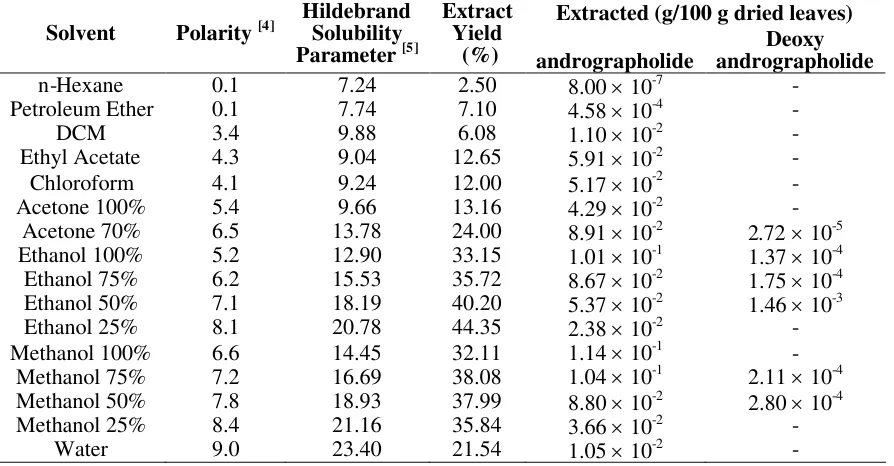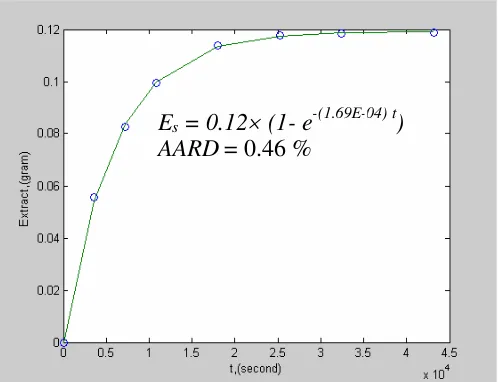Project No. F0125/2004D Andri Cahyo Kumoro
Experimental and Modeling Studies of Andrographolide Extraction from
Andrographis paniculata
in a Soxhlet Extractor
Andri Cahyo Kumoro and Masitah Hasan
Department of Chemical Engineering, Faculty of Engineering University of Malaya
Lembah Pantai 50603 Kuala Lumpur Email: [email protected]
Abstract
Andrographolide is the main diterpenoid lactone contained in the leaves ofAndrographis paniculata. This bioactive component has multifunctional medicinal properties such as activity against fever, dysentery, diarrhoea, inflammation, and sore throat as well as immune disorder. The objectives of this work were to study the effect of polarity and Hildebrand solubility parameter of solvents in the extraction of andrographolide from A. paniculataand to develop a mathematical model to quantitatively describe the extraction phenomena. The extraction was carried out by employing various organic solvents and their mixtures with water as solvents using standard soxhlet method. Five grams of ground - dried A. paniculata leaves was extracted using 1.50 10-4 m3of solvent for 10,800 seconds. The standard soxhlet extraction method was conducted using methanol at different extraction times to verify the mathematical model proposed in this work. The crude extracts were then analysed for their andrographolide content using high performance liquid chromatography. Methanol was found to be the best solvent for the extraction of andrographolide from A. paniculata. The Hildebrand solubility parameter concept was not able to predict the extraction of andrographolide using polar organic solvents. The final form of the proposed model based on rapid mass transfer at the interphase of the solid-liquid surface and the introduction of volumetric mass transfer coefficient isEs= 0.12(1- e-(1.69E-04) t), whereEs= total extract, (g) andt= extraction time,
(second). The model showed good agreement with the experimental data by generating AARDof about 0.46 %.
Keywords: Experimental, modelling, andrographolide, extraction, Andrographis paniculata
1.0 Introduction
Andrographis paniculata NEES grows widely in the tropical areas of South East Asia, India and China with annual growth of 0.30 - 0.70 m height. This plant has been widely used for traditional medicine and help against fever, dysentery, diarrhoea, inflammation, and sore throat. It is also found to be a promising new way for the treatment of HIV, AIDS, and numerous symptoms associated with immune disorders [1].
Three main diterpenoid lactones identified in the A. paniculata leaves were andrographolide, neo-andrographolide and deoxyandrographolide [2, 3]. The molecular formula of andrographolide is C20H30O5, while its molecular structure is shown in Figure 1.
228o – 230oC and the ultraviolet spectrum in ethanol,
maxis 223 nm. The analysis of
andrographolide can be done by thin layer chromatography (TLC) [3], high - performance liquid chromatography (HPLC) [2, 3] and crystallisation [3].
Figure 1. Molecular structure of andrographolide [3]
The liquid solvent extraction is the most common method for separating bioactive components from their natural resources. The advantages of this method over other extraction methods are as follows [4]: (i) the sample is repeatedly brought into contact with the fresh portions of the solvent, thereby helping to displace the transfer equilibrium, (ii) the temperature of the system remains relatively high due to the heat applied to the distillation flask, (iii) sample throughput can be increased by simultaneous extraction in parallel, (iv) it has the ability to extract more sample mass and it is non-matrix dependent. However, for toxicological reason, drug and medicine producers are required to minimise the number and amount of solvents employed in pharmaceutical processes. The presence of a solvent in the extract may also affect the kinetics of crystallisation and the crystal morphology of the product [5].
In order to optimise the utilisation of solvent in the extraction of bioactive components from natural resources, an estimation of the extract yield obtained is necessary. The objectives of this work were to study the effect of polarity and Hildebrand solubility parameter of solvents in the extraction of andrographolide from A. paniculata and to develop a mathematical model to quantitatively describe the extraction phenomena.
2.0 Materials and methods 2.1. Materials
The leaves of A. paniculata were collected from Malaysian Agricultural Research and Development Institute (MARDI). Andrographolide standard compound (98 % purity) was supplied by Sigma - Aldrich (M) Sdn. Bhd. and deoxyandrographolide standard compound (99 % purity) was purchased from LKT Laboratories, Inc. (USA). Various organic solvents (Merck, HPLC grade, 99.8%) were purchased from Bibi Saintifik Sdn. Bhd., while deionised water was generated in the Analytical Laboratory, Department of Chemical Engineering, University of Malaya
2.2 Solvent extraction
using vacuum rotary evaporator (BÜCHI Rotavapor Model R-144, Switzerland) and completely dried in an atmospheric oven. The crude extracts were then analysed for their andrographolide content using high performance liquid chromatography.
2.3 Modelling of extraction using soxhlet extractor
In order to describe the andrographolide transfer from the leaf particles to the bulk of the solvent, the following hypotheses were used: (i) every leaf particle is symmetrical, (ii) the mass transfer coefficient is constant, (iii) the solvent in the extractor is perfectly mixed, while the transfer resistance in the liquid phase is negligible and the andrographolide concentration in the solvent depends only on time, (iv) the transfer of the andrographolide is a diffusion phenomenon and independent of time, (5) at the interface, the concentration of andrographolide in the solution between the internal liquid (in pores) and external to particles are equal. The final form of the equation obtained from this modelling is:
.(1 Dt)
s
E B e (1)
whereEs= total extract (g),t= extraction time (seconds), andB&D= equation constants.
3.0 Results and discussions
The results of this work are presented in Table 1 and Figure 2. In comparison to non - polar solvents, polar solvents could extract andrographolide at higher yield except water, where hydrolysis and thermal degradation might occur. Methanol was found to be the best solvent for the extraction of andrographolide. Ethanol and aqueous acetone extracted andrographolide at lower yield although their Hildebrand solubility parameters are closer to that of andrographolide. Solvents having moderate polarity extracted andrographolide much lower than ethanol did. Non - polar solvents were almost not able to extract andrographolide.
Table 1. Effect of solvent polarity and Hildebrand solubility parameter on extraction yield.
Extracted (g/100 g dried leaves)
Figure 2. Comparison of extract weight calculated from the model and experimental data
4.0 Conclusions
Methanol was found to be the best solvent for the extraction of andrographolide from Andrographis paniculata. However, the Hildebrand solubility parameter concept was not able to predict the extraction of andrographolide using polar organic solvents. The final form of the proposed model isEs= 0.12(1- e-(1.69E-04) t), having anAARDof about 0.46 %.
5.0 Acknowledgement
The authors would like to express their gratitude to the University of Malaya for the financial support through its short term research grant Vot F. No. F0125/2004D.
6.0 References
[1] Calabrese, C., Berman, S. H. & Babish, J. G. (2000). A phase I trial of andrographolide in HIV positive patients and normal volunteers,Phytotherapy Research, 14, 333 - 338.
[2] Wongkittipong, R., Prat, L., Damronglerd, S. & Gourdon, C. (2000). Solid - liquid extraction of andrographolide from plants - experimental study, kinetic reaction and model, Separation and Purification Technology, 40, 147-154.
[3] Rajani, M., Shrivastava, N. & Ravishankara, M. N. (2000). A rapid method for isolation of andrographolide from Andrographis paniculata Nees (Kalmegh), Pharmaceutical Biology, 38, 204 -209.
[4] Luque de Castro, M. D. and Garcia-Ayuso, L. E. (1998). Soxhlet extraction of solid materials: an outdated technique with a promising innovative future, Analitica Chimica Acta, 369, 1-10.
[5] Kolar, P., Shen, J. W., Tsuboi, A & Ishikawa, T. (2002). Solvent selection for pharmaceuticals,Fluid Phase Equilibria,194 - 197, 771-782.
Es= 0.12(1- e-(1.69E-04) t)
![Figure 1. Molecular structure of andrographolide [3]](https://thumb-ap.123doks.com/thumbv2/123dok/1133053.654101/2.595.235.375.140.250/figure-molecular-structure-of-andrographolide.webp)

